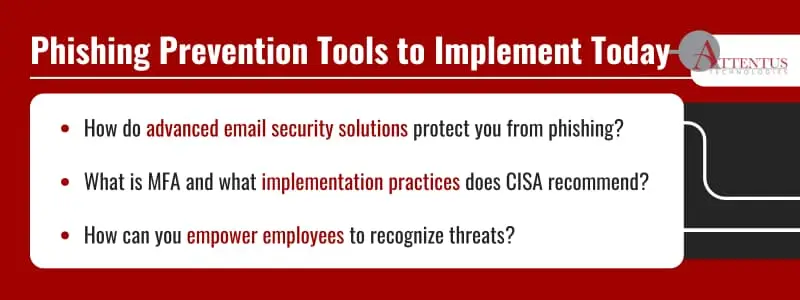With nearly a million phishing attacks in Q4 2024, SMBs can’t afford to “wait and see” whether they’ll be a target. Here are the strategies and tools to protect your business.

How are you managing cybersecurity as phishing attacks become more prevalent?
The Anti-Phishing Working Group (APWG) observed 989,123 phishing attacks in Q4 2024, representing a 12.7% and 6% increase from the year’s Q2 and Q3 figures, respectively.
The potential negative financial impact is also rising. APWG’s report found the average wire transfer amount requested in business email compromise (BEC) attacks reached $128,980 in Q4, for example, nearly double Q3’s average of $67,145.
That’s not a small amount for SMBs.
Could one of your employees be the next target of a BEC or other phishing attack? You need proactive measures to safeguard your company’s assets, reputation, and bottom line.
Here are three cybersecurity strategies to reduce your organization’s vulnerability to phishing attacks.
1. Implement Advanced Email Security Solutions to Protect Your Inbox from Malicious Threats
Do you have a reliable solution to detect and block phishing emails?
There are many advanced email protection tools like Barracuda Email Protection and IronScales available today. These solutions:
- Utilize multi-layered, cloud-hosted scanning engines.
- Combine behavioral analysis, heuristic evaluation, and sandboxing technologies.
- Detect even zero-day threats and sophisticated ransomware variants.
Your email security solution automatically scans suspicious attachments in real-time when they arrive, “detonating” the unknown files in isolated sandbox environments to observe their behavior without risking your systems.
Similarly, link protection features redirect suspicious URLs through secure channels, preventing inadvertent malware downloads when employees click something they shouldn’t.
Lastly, multi-factor authentication (MFA) can add a layer to your phishing defence strategy once your email security solution is in place.
2. Enforce MFA for an Extra Layer of Security
Think passwords are enough to prevent account compromises? Think again.
Strong passwords considerably reduce the chance of a breach, but one challenge remains: they don’t authenticate that the person on the other end is the account owner. That’s where MFA comes in.
With MFA, someone must provide additional proof of identity before logging into your systems. This includes:
- Something they know (password or PIN).
- Something they have (a mobile device or a security key).
- Something they are (biometrics).
These authentication factors considerably minimize the risk of unauthorized access when credentials have been stolen or exposed. Businesses can thwart 99.9% of account compromise attempts by enforcing MFA, according to Microsoft.
The Cybersecurity and Infrastructure Security Agency (CISA) recommends:
- Using a solution with Fast IDentity Online (FIDO) authentication protocols that block attempted logins into malicious websites
- Or leveraging numbers matching MFA to block SMS-based attacks and push bombing
Implementation should be thoughtful, plus balance security requirements with user experience to minimize friction in daily workflows. A reliable partner can help you strategize on how to do just that.
3. Conduct Regular Cybersecurity Training That Empowers Your Team to Recognize Threats
Are your employees an asset or vulnerability in your cybersecurity efforts? 60% of breaches are due to human error, according to Verizon’s 2025 Data Breach Investigations Report, creating a need for ongoing training within organizations.
Here are a few things to keep in mind:
- Platforms like SafeTitan and MetaCompliance offer behavior-driven security awareness training that adapts to each employee’s specific actions and vulnerabilities.
- Leading security training software provides fully automated phishing simulations using thousands of templates.
- “Multi-lure” capabilities help to create random but realistic phishing scenarios.
- This approach keeps employees engaged and prevents them from simply memorizing a few examples without developing genuine threat recognition skills.
And good news: it works. SafeTitan says its platform can reduce staff susceptibility to phishing by up to 92%.
Efficient and effective training means you will be closer to achieving a security-first culture where phishing attacks against your organization don’t stand a chance.
Activate Proactive Measures for Long-Term Protection
A multi-layered strategy can make all the difference in cybersecurity resilience. The combination of advanced email security, multi-factor authentication, and employee cybersecurity training provide practical defenses against the rising tide of phishing attacks.
It’s time to assess your security posture:
- Where are you with your cybersecurity?
- How many of these strategies and tools have you implemented?
- Are you effectively filtering malicious emails?
- Does your MFA align with CISA standards?
- Is your training solution actually bringing the results you want?
A single data breach now costs $4.88 million, according to IBM, and security cannot be an afterthought. Attentus Technologies can provide expert guidance to keep you ready for whatever phishing attack comes next.
For over 20 years, we’ve built trusted relationships with SMBs by helping them implement the right strategies and tools for true peace of mind. Guided by core values like “Be the Answer” and “Deliver Exceptional Results,” we focus on long-term impact, not quick fixes. That commitment has earned us a 97.5% customer satisfaction rating and a 10-year average client retention rate. We’d love the opportunity to do the same for you!
Contact us for a comprehensive security assessment today.
